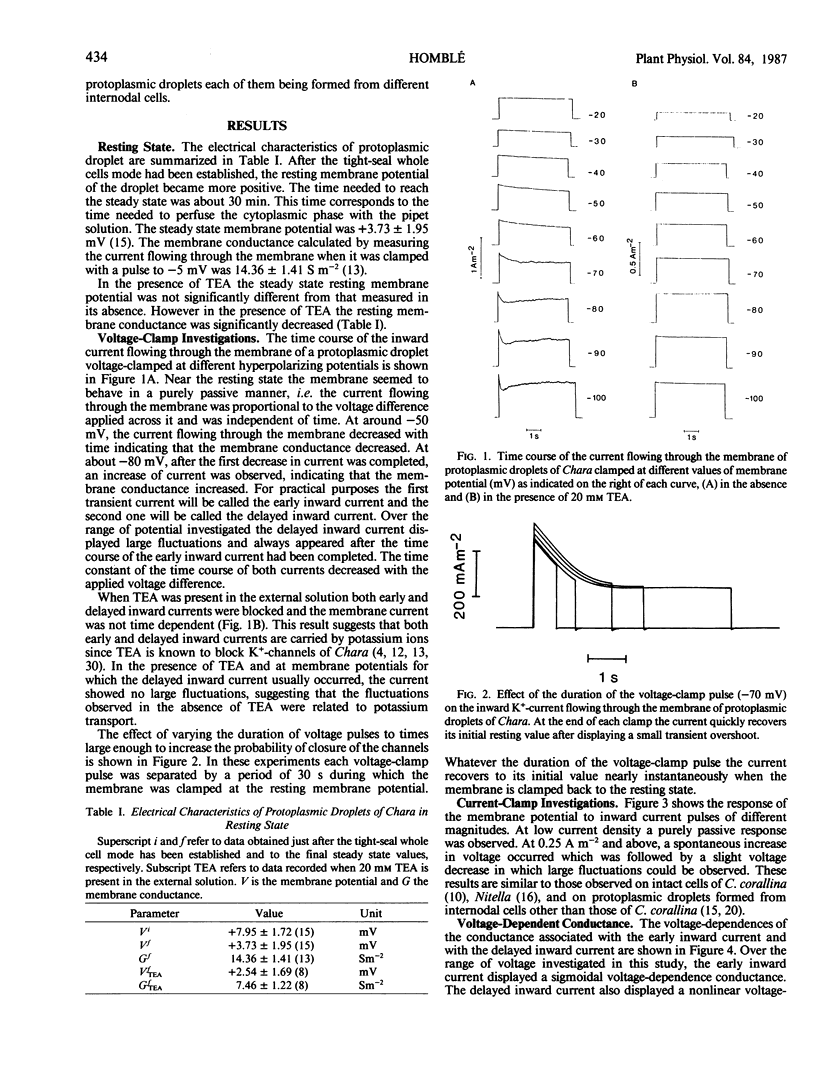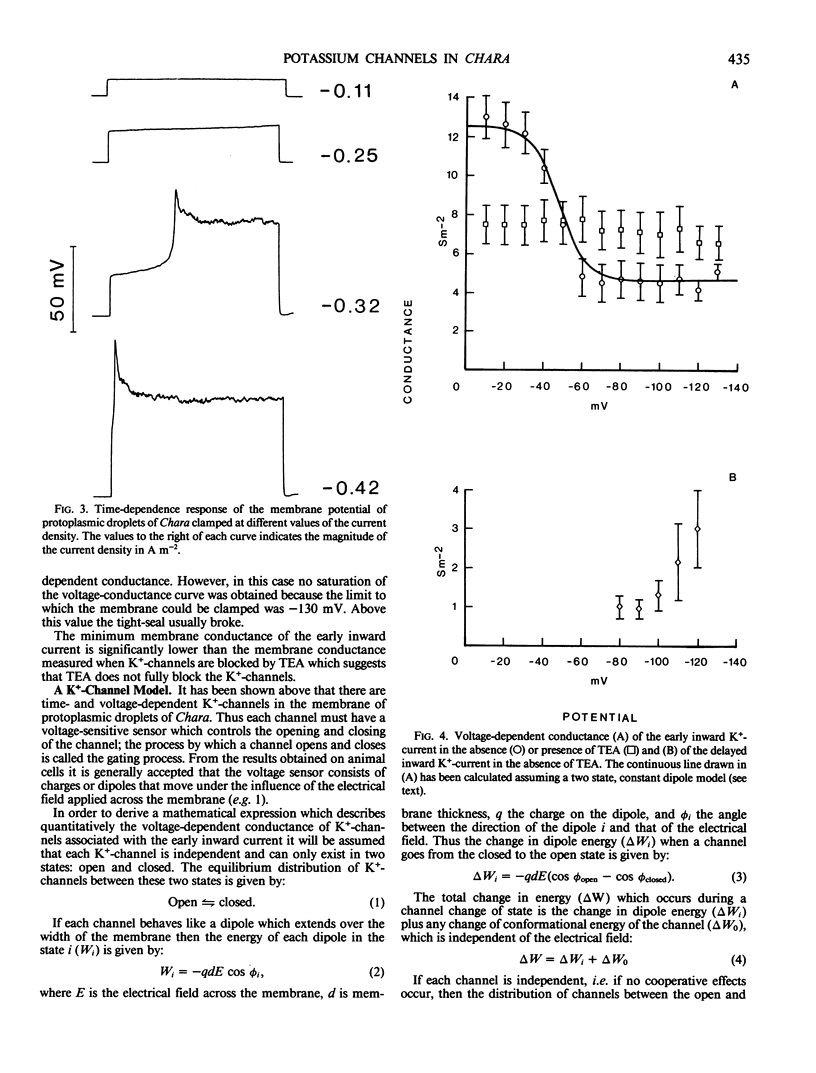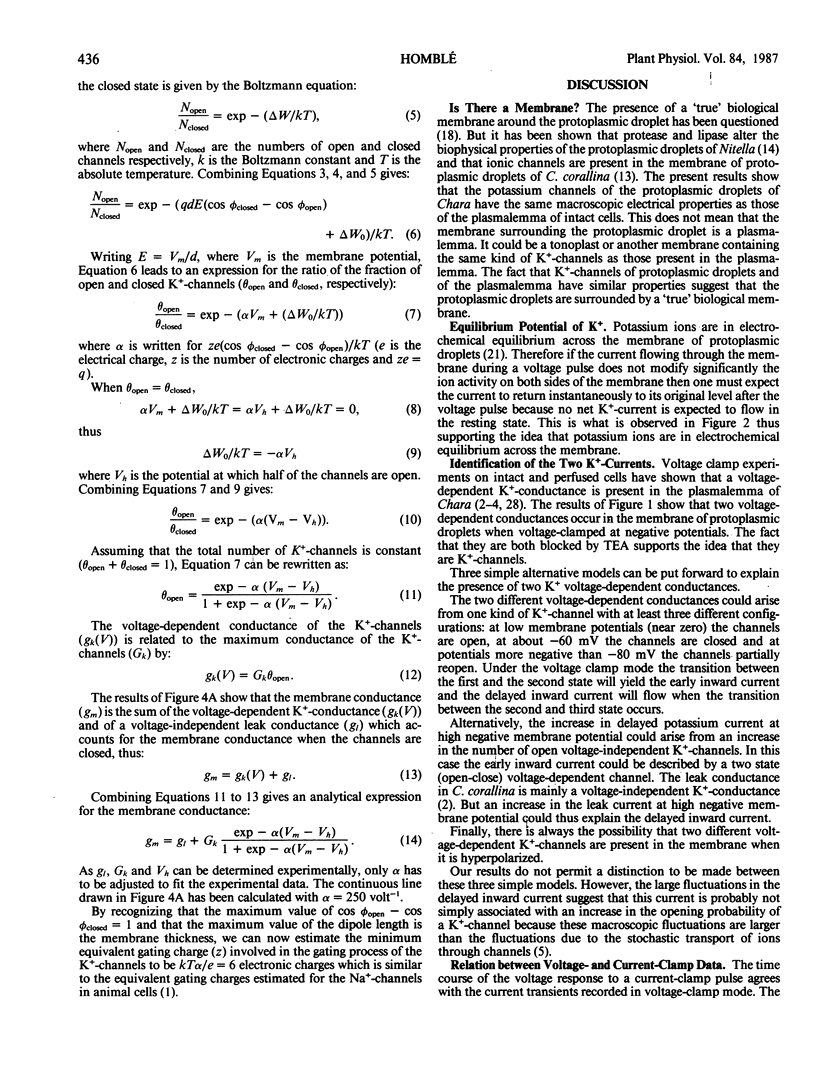Abstract
The biophysical properties of voltage-dependent K+-channels of protoplasmic droplets of Chara corallina Klein ex Willd., em, R.D.W. were investigated using the tight-seal whole cell method. Two potassium currents were observed in voltage-clamp mode and they can be used to explain the transient membrane potential time course observed in current-clamp mode. The K+-channels are identified by the effect of tetraethylammonium chloride which blocks both currents. A two-state, constant dipole moment model is used to fit the voltage-conductance curve. From this model the minimum equivalent gating charge involved in the gating mechanism of K+-channels of Chara can be estimated.
Full text
PDF




Selected References
These references are in PubMed. This may not be the complete list of references from this article.
- Almers W. Gating currents and charge movements in excitable membranes. Rev Physiol Biochem Pharmacol. 1978;82:96–190. doi: 10.1007/BFb0030498. [DOI] [PubMed] [Google Scholar]
- Bisson M. A. Calcium effects on electrogenic pump and passive permeability of the plasma membrane of Chara corallina. J Membr Biol. 1984;81(1):59–67. doi: 10.1007/BF01868810. [DOI] [PubMed] [Google Scholar]
- Ferrier J. M., Morvan C. Plasmalemma Voltage Noise in Chara corallina. Plant Physiol. 1979 Apr;63(4):709–714. doi: 10.1104/pp.63.4.709. [DOI] [PMC free article] [PubMed] [Google Scholar]
- GAFFEY C. T., MULLINS L. J. Ion fluxes during the action potential in Chara. J Physiol. 1958 Dec 30;144(3):505–524. doi: 10.1113/jphysiol.1958.sp006116. [DOI] [PMC free article] [PubMed] [Google Scholar]
- Hamill O. P., Marty A., Neher E., Sakmann B., Sigworth F. J. Improved patch-clamp techniques for high-resolution current recording from cells and cell-free membrane patches. Pflugers Arch. 1981 Aug;391(2):85–100. doi: 10.1007/BF00656997. [DOI] [PubMed] [Google Scholar]
- Homblé F., Ferrier J. M., Dainty J. Voltage-Dependent K-Channel in Protoplasmic Droplets of Chara corallina: A Single Channel Patch Clamp Study. Plant Physiol. 1987 Jan;83(1):53–57. doi: 10.1104/pp.83.1.53. [DOI] [PMC free article] [PubMed] [Google Scholar]
- Inoue I., Ishida N., Kobatake Y. Studies of excitable membrane formed on the surface of protoplasmic drops isolated from Nitella. IV. Excitability of the drop membrane in various compositions of the external salt solution. Biochim Biophys Acta. 1973 Nov 30;330(1):27–38. doi: 10.1016/0005-2736(73)90281-2. [DOI] [PubMed] [Google Scholar]
- Inoue I., Ueda T., Kobatake Y. Structure of excitable membranes formed on the surface of protoplasmic drops isolated from Nitella. I. Conformation of surface membrane determined from the refractive index and from enzyme actions. Biochim Biophys Acta. 1973 Mar 29;298(3):653–663. doi: 10.1016/0005-2736(73)90081-3. [DOI] [PubMed] [Google Scholar]
- Koppenhöfer E., Ode A., Rimmel C., Schramm M., Schuback P., Schumann H. Isolated Nitella protoplasm is not excitable. J Theor Biol. 1977 Oct 7;68(3):449–451. doi: 10.1016/0022-5193(77)90071-6. [DOI] [PubMed] [Google Scholar]
- Ross S., Dainty J. Membrane Electrical Noise in Chara corallina: I. A Low Frequency Spectral Component. Plant Physiol. 1985 Dec;79(4):1021–1025. doi: 10.1104/pp.79.4.1021. [DOI] [PMC free article] [PubMed] [Google Scholar]


